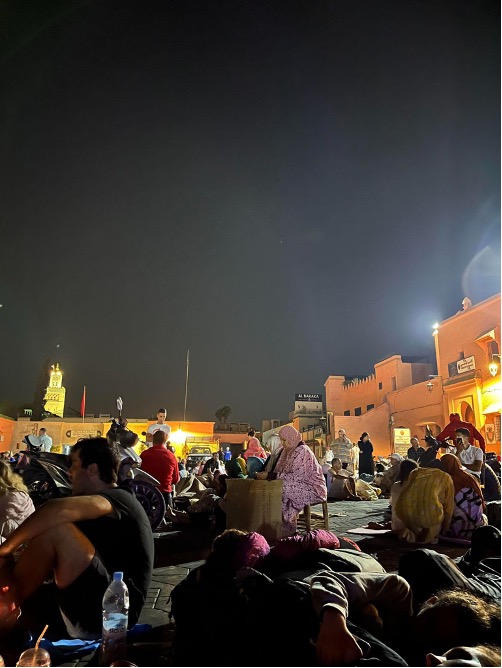Saavi Natekar - ReportLearning and Unlearning in Morocco.During my final semester of Architecture, just months shy of graduation, I stumbled upon an enticing opportunity: a fellowship in Morocco. Initially, the idea of immersing myself in Moroccan culture for a couple of months felt like a whimsical dream. Yet, as the visa was approved and the departure date loomed, the reality of the adventure ahead began to sink in. Armed with only "Oui" as my French vocabulary, even the immigration officer expressed concern as I embarked on my solo journey to Casablanca in late July. However, with each step towards Fès, my apprehension ebbed away, replaced by a growing sense of excitement and warmth from the prospect of what lay ahead. Aziza Chaouni Projects (ACP), located in the Ville Nouvelle (New City) of Fès, became my haven. With a modest team of around ten designers, ACP tackled a myriad of diverse projects. From day one, I braced myself for a departure from the conventional design approaches ingrained by my college curriculum. ACP's ethos placed users at the core of the design process, fostering collaborative solutions that resonated deeply with me. My initiation into ACP involved crafting a design toolkit for upcoming workshops in Agadir. In 2023, the Regional Tourism Development Company (SDRT) of the Souss Massa Region invited ACP to spearhead ecotourism initiatives. These ventures aimed to blend innovative design with vernacular techniques, all while minimizing environmental impact. Our mission: to engage stakeholders, from elected officials to local communities, in a co-creative process to shape the future of three strategic sites: Boutbouqalt, Targua N’touchka, and Anmel.
Nestled within Fès beats the heart of Fez el Bali, affectionately known as the old Medina of Fès, a living embodiment of Morocco's profound heritage. This pedestrian medieval enclave, home to over 200,000 residents, weaves a tapestry of small-scale edifices and labyrinthine alleys. Welcomed into the abode of a gracious resident named Rose and her family of nine cats, I found myself momentarily enfolded into this enchanting ecosystem. This tightly knit district pulsates with the energy of artisans and culinary delights, infusing the air with vibrancy. Spanning 220 hectares, it harbors bustling markets, venerable mosques, venerable universities, and even discreet industrial facilities amidst its maze-like streets. Remarkably, despite its lively bustle, one can traverse its entirety on foot within a mere 40 minutes.For those yearning for solace from the urban hustle, the tranquil countryside beckons just beyond the ancient city walls.
The lack of cars in Fez is in part due to its urban structure. Here, primary activities—such as living, working, and leisure—are all interwoven, ensuring proximity between residences, workplaces, and social hubs. This close-knit layout significantly reduces travel distances, rendering car usage unnecessary. Additionally, this mixed-use design fosters a vibrant cityscape, characterized by constant activity and abundant social interaction. Embracing life within its labyrinthine lanes, I swiftly gained a mental map of this historic district, understanding not only its architectural intricacies but also the nuances of modernization within its tourist hubs. Venturing beyond Fès, each Medina unveiled its unique narrative. Meknes, founded as a military stronghold in the 11th century, stood as the economic hub of the Fès region, its Medina a juxtaposition of compact alleys and expansive Kasbahs. Meanwhile, Rabat, with its grand Kasbah overlooking the Atlantic, offered a stark contrast between bustling souks and serene garden sanctuaries.
A seismic upheaval, unseen in generations, shook Marrakech Medina to its core—a 6.8 magnitude earthquake that tore the ancient fabric of the city asunder, leaving behind a landscape marred by devastation. Once-stalwart structures crumbled, their echoes mingling with the cries of the afflicted in the maze of narrow streets now strewn with rubble.
Amidst the turmoil, we sought refuge in the expansive embrace of Jemma el-Fnaa square. Here, amidst the somber prayers of families and the mournful lamentations of the less fortunate, a glimmer of resilience pierced the darkness—a testament to the enduring spirit of the city. In the company of newfound companions, we drew strength from the shared solidarity that flowed through the city, binding us together in the face of adversity. As dawn broke, casting its pale light upon the fractured landscape, we emerged—bruised but unbowed, resolved to rebuild and endure.
What began as a personal retreat to Fès turned into a commitment to aid those devastated by the earthquake. Every night at the Market Square the trucks would assemble to collect any relief for the victims. From clothes to mattresses to even tents. Witnessing the outpouring of support from communities rallied my resolve to contribute to the recovery efforts. In Douzrou, over 97 families lost their homes to boulders during the earthquake. Though lives cannot be restored, ACP is aiding in family rehabilitation. Homes were designed in modular form, using reinforced bricks for earthquake resilience and quick construction. The settlement layout, adapted to mountain terrain, retains the original contours, forming a stepped settlement plan with interconnected homes facing minor streets converging into larger community nodes.
In villages like Douzrou, where families lost everything to nature's wrath, ACP's initiatives offered a glimmer of hope. Through innovative design solutions, we aimed not only to rebuild homes but also to foster a sense of community resilience. As I bid farewell to Fès, my journey back to India was marked not only by a life-changing experince but a renewed perspective towards a design professional and the role we play in creating inclusive, resilient urban spaces.
Additional Help and InformationAre you in need of assistance? Please email info@berkeleyprize.org. |
|
















